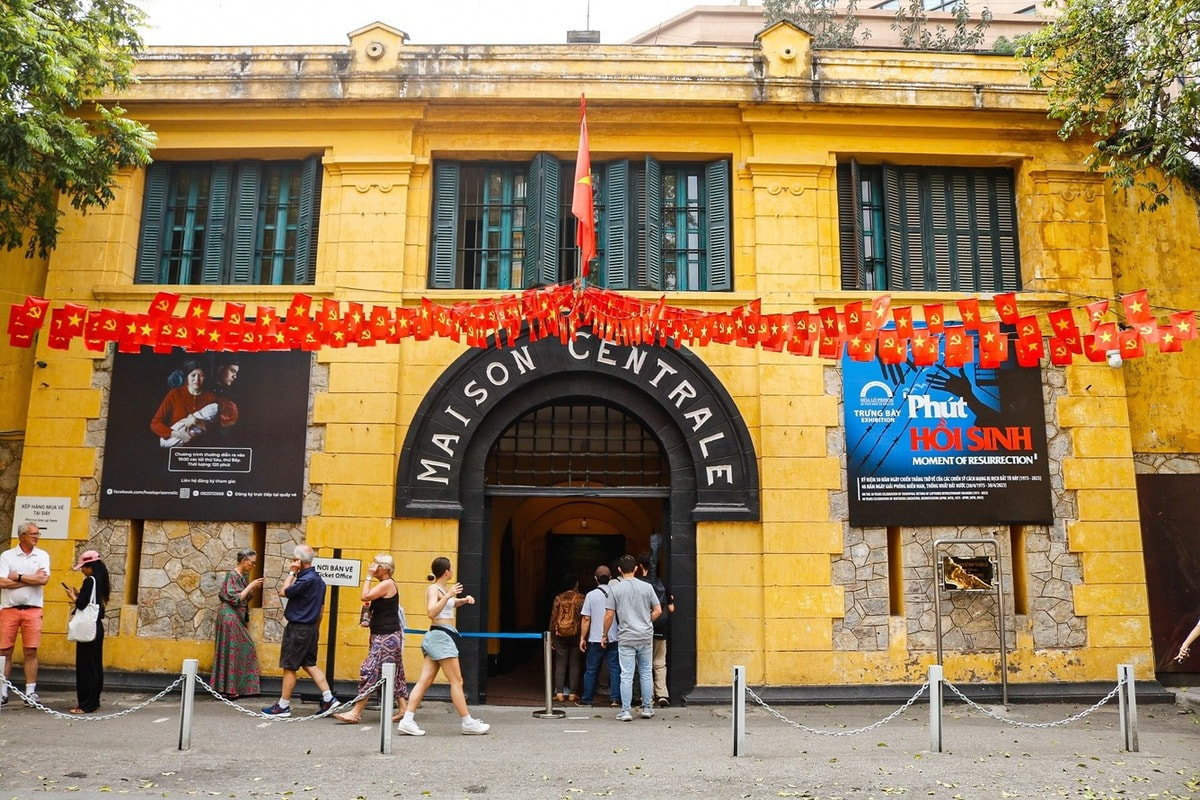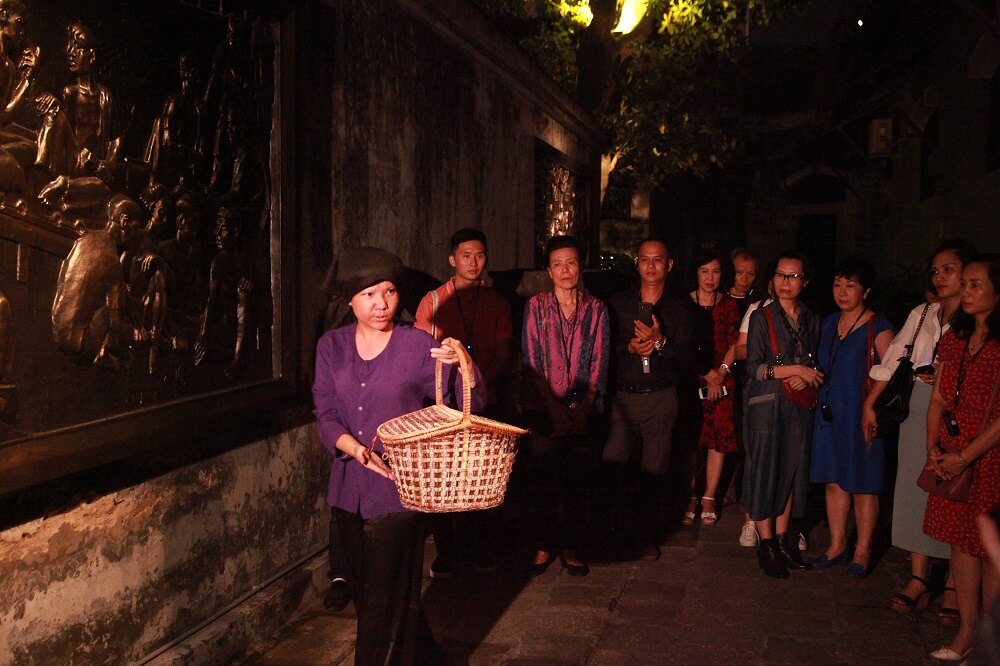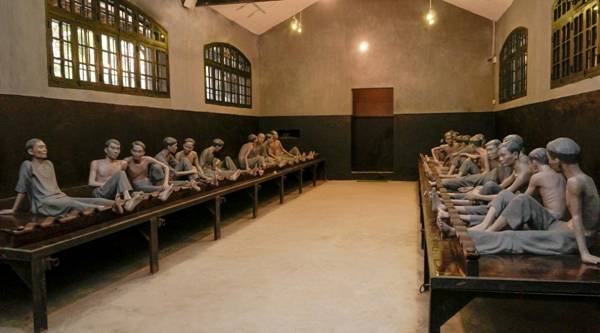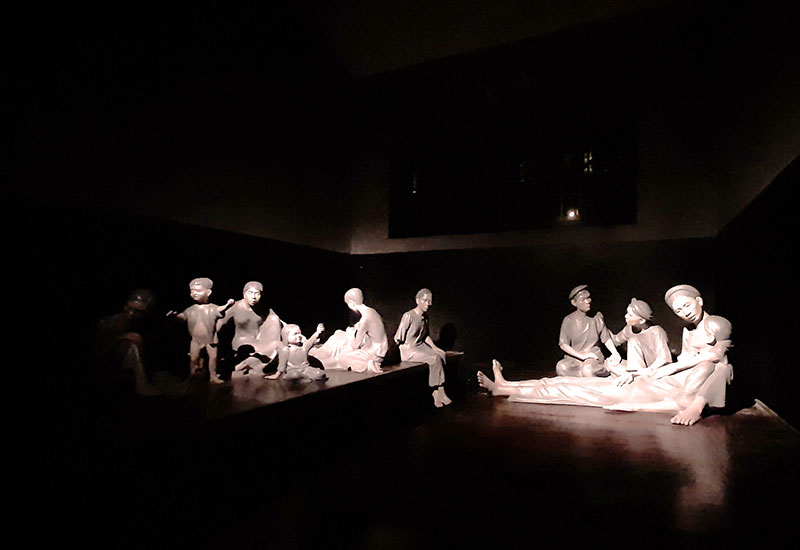Hoa Lo Prison Museum Hanoi: Discover Hanoi’s most powerful historical experience
If you seek to understand the deeper layers of Vietnam, a visit to the Hoa Lo Prison Museum Hanoi is both moving and unforgettable. Standing quietly amid the city’s modern buzz, this historic site tells stories of courage, endurance, and freedom. In this complete guide, you’ll uncover the gripping Hoa Lo Prison, learn practical visitor tips
Overview of the Hoa Lo Prison Museum Hanoi
Address: No. 1 Hoa Lo Street, Hoan Kiem District, Hanoi.
Known locally as Nhà Tù Hỏa Lò, Hoa Lo Prison Museum is one of Hanoi’s most powerful historical attractions. The name “Hỏa Lò” literally means “fiery furnace” or “hell hole”, which feels eerily fitting once you step inside.

Originally built by the French colonial government in the late 19th century, the prison was designed to house Vietnamese revolutionaries who opposed colonial rule. Later, during the Vietnam - US conflict, it became known to American prisoners of war as the “Hanoi Hilton.” Today, the site has been transformed into a museum, preserving relics, photographs, and reconstructions that depict the lives of prisoners, both Vietnamese patriots and American pilots who endured its harsh walls.
Hoa Lo Prison Museum opening hours
Before planning your visit to Hoa Lo Prison Museum Hanoi , it’s essential to know the hoa lo prison opening hours and best times to explore.
Opening hours: 8:00 AM - 5:00 PM (Daily)
Closed: Some public holidays (check locally during Tet - Lunar New Year)
Recommended Duration: 1-1.5 hours
Best time to visit: Morning visits (before 10 AM) are ideal to avoid tour crowds and enjoy cooler temperatures. The museum’s indoor setting makes it suitable even on rainy days.
Hoa Lo prison museum entrance fee
Entry to the museum is affordable, and the experience is worth it.
Ticket price: 30,000 VND/person. Some special groups will be exempted from the ticket fee or receive a discount, specifically as follows:
- Children under 15 years old.
- People with severe disabilities.
- Members of: Veterans Association, National Prison Liaison Committee and Resistance Liaison Committee.
- People with revolutionary contributions.
Cases that are entitled to a 50% discount on the ticket price:
- Students (Present student/student card when purchasing tickets).
- People with severe disabilities.
- Vietnamese citizens aged 60 and over.
- People classified as social policy beneficiaries.
In addition, Hoa Lo also provides headphone commentary services at a price of 50,000 VND/headphone.
The history behind the “Hell on Earth”
The French began constructing Hoa Lo Prison in 1896 to detain political dissidents. The complex originally spanned over 12,000 square meters and was among the largest and most notorious colonial prisons in Indochina. Inside, prisoners faced severe conditions - overcrowded cells, minimal food, chains that bound them day and night. Yet, amid this hardship, the prison became a place of resistance and unity. Many revolutionaries, including well-known figures in Vietnam’s independence movement, were detained here.

After Vietnam gained independence, Hoa Lo took on a new role during the Vietnam War (1960s - 1970s), when captured American pilots, including future U.S. senator John McCain were imprisoned here. The U.S. POWs ironically nicknamed it the “Hanoi Hilton,” a dark nod to its reputation.
The museum now displays both eras:
- One section illustrates the colonial struggle and the resilience of Vietnamese revolutionaries.
- Another shows the American POW experience, including uniforms, photographs, and artifacts.
Rather than glorifying pain, the museum invites reflection showing how courage and hope can survive even in the darkest places.
Experience the Hoa Lo Prison museum night tour
While the daytime visit to Hoa Lo Prison Museum reveals the nation’s tragic yet heroic past, the night tour called “Sacred Night” (Đêm Thiêng Liêng) - transforms the experience into something far more immersive and emotional.
The “Sacred Night” series is held every weekend, offering three distinctive programs - each with its own storyline and emotional tone.
Friday & Sunday evenings: Themes “The Glorious Vietnamese Spirit” and “Living Like Flowers”
Time: 7:00 PM - 8:30 PM (90 minutes)
These two versions focus on the unyielding courage of revolutionaries and the quiet strength of Vietnamese women who endured captivity with dignity and hope.
Saturday Evening: Theme “The Fire of Youth”
Time: 7:00 PM - 9:00 PM (120 minutes)
This longer program pays tribute to the patriotic passion of Vietnam’s young generation - students and idealists who burned bright for their country’s freedom.
Ticket prices
- “The Glorious Vietnamese Spirit” / “Living Like Flowers”: 399,000 VND per person
- “The Fire of Youth”: 499,000 VND per person
Tickets can be purchased directly at the Hoa Lo Prison Museum entrance or through authorized travel partners.

Night 1: The glorious Vietnamese spirit
This opening theme is a heartfelt tribute to generations of patriots who fought and sacrificed for the nation’s independence. Visitors are transported back to the colonial era, witnessing moving scenes that honor the unyielding courage of Vietnamese revolutionaries under French rule.
Through dramatized reenactments, artifacts, and solemn narration, the tour recreates moments of heroism that inspire both pride and reverence.
You’ll find yourself deeply moved by the unbreakable determination that carried Vietnam through one of its darkest periods.
Night 2:Living like flowers
This theme celebrates the strength and grace of Vietnamese women who endured the harsh conditions of imprisonment yet continued to live with dignity, compassion, and hope.
Through emotional storytelling and carefully staged performances, the tour honors the female revolutionaries whose beauty shone brightest in adversity.
You’ll hear tales of sisterhood, courage, and the unshakable belief in a brighter future - a deeply touching reminder of the role women played in Vietnam’s struggle for freedom.
Night 3: The fire of youth
This night’s program focuses on the passionate spirit of Vietnam’s youth during the anti-French resistance.
Visitors encounter stories of young students and patriots who sacrificed their dreams, comfort, and even their lives for the nation’s independence. The atmosphere is both stirring and nostalgic - filled with energy, emotion, and patriotism. It’s an inspiring night that rekindles pride and reminds all generations of the enduring flame of Vietnamese youth.
The unique architecture of Hoa Lo prison museum Hanoi
The Hoa Lo Prison Museum is not only a place of remembrance but also a striking example of French colonial architecture in Hanoi. Built between 1896 and 1899, the prison originally called Maison Centrale was designed to reflect both European engineering precision and the harsh control of a colonial regime.
Covering more than 12,000 square meters, Hoa Lo was once one of the largest prisons in French Indochina. Its four-meter-high granite walls, topped with broken glass and electric wire, created a sense of complete isolation. Inside, narrow brick corridors, iron-barred windows, and tiny cells emphasized the system’s brutality and the prisoners’ suffering.

Among the preserved sections today are the main entrance gate with the French inscription “Maison Centrale,” the cell blocks, and the execution room that once housed a French guillotine. Each corner reveals the stark contrast between architectural order and human pain. Yet, within this oppressive structure, Vietnamese revolutionaries found ways to resist - sharing news, organizing uprisings, and keeping their spirit alive. This paradox gives Hoa Lo’s architecture a unique duality: it was built to confine, but it became a symbol of freedom.
Now transformed into a museum, Hoa Lo stands as both a historical landmark and a testament to resilience, where the cold stone walls continue to whisper stories of courage from a century past.
What to expect inside the Hoa Lo Prison Museum?
The museum is laid out like a journey through time, beginning with the French colonial era and ending with the American War period. Each room is a window into a different chapter of Vietnam’s complex struggle for independence and resilience.
The main cell blocks
Your tour begins inside the colonial cell blocks, built from dark stone and iron more than a century ago. Narrow corridors stretch ahead, dimly lit by hanging lamps. Rows of wooden cells line both sides, each one preserved with eerie authenticity.

Inside, life-sized mannequins depict Vietnamese prisoners chained to stone slabs, their faces etched with pain and defiance. Iron shackles still lie on the cold floors, and you can almost imagine the clinking of metal echoing through the corridors as guards passed by.
But amid the gloom, there is also a story of courage. Information panels reveal how detainees - many of them Vietnamese revolutionaries, secretly passed messages, organized underground resistance, and even printed leaflets inside the prison. In the darkest of places, the seeds of freedom were being sown.
The women’s cell and stories of solidarity
Here, visitors learn about women who were imprisoned for their political activism - mothers, students, even young girls. Displays highlight how they endured harsh treatment but remained strong through unity.

A small corner dedicated to Nguyen Thi Minh Khai, one of Vietnam’s revolutionary heroines, shows her writings and photographs. Her courage continues to inspire generations of Vietnamese women today.
The death row & guillotine room
Further inside lies the most chilling part of the museum: the death row and guillotine chamber. At the center of the room stands the original French guillotine, its steel blade gleaming under a faint spotlight. It’s both mesmerizing and horrifying - a stark reminder of colonial brutality.

Behind it, black-and-white photographs document the faces of those executed here, along with letters written to their families hours before their deaths. Some letters speak of fear, others of pride and hope for independence. Many visitors pause here in silence - it’s impossible not to feel the weight of what these walls have witnessed.
This section captures exactly why Hoa Lo was known as “Hell on Earth.” Yet it also reveals the extraordinary endurance of those who refused to be broken.
The American pow section – The “Hanoi Hilton”
Transitioning to a different era, the next area focuses on the American prisoners of war held here during the 1960s and 1970s.
You’ll see the uniforms and belongings of captured U.S. pilots, including photographs of John McCain and other notable POWs. Exhibits display their letters home, playing cards, books, and even Christmas decorations made during captivity. The contrast between this and the earlier colonial brutality is striking - it mirrors Vietnam’s transformation from occupied nation to independent state.
Artifacts, audio guides & interactive exhibits
Throughout the museum, authentic artifacts connect the past to the present - rusted chains, hand-forged tools, prisoner uniforms, and even old typewriters used to produce secret documents.

Large-scale photographic panels illustrate daily life inside Hoa Lo, while audio-visual installations replay interviews and wartime footage. English, French, and Vietnamese descriptions make the experience accessible to all visitors.
If you opt for the audio guide, you’ll hear survivors’ voices narrating what happened in these very rooms.
A walk through memory
By the time you exit through the small courtyard, where a few remnants of the original prison walls still stand, you’ll carry more than just facts. You’ll carry a feeling. The weight of oppression, yes, but also the light of resilience.
Many travelers describe leaving Hoa Lo Prison Museum with a quiet sense of reflection, realizing that this isn’t merely a place of pain - it’s a monument to the human spirit. If you’re visiting Hanoi to understand its culture and history, this is the one site you cannot miss.
Visitor tips for a meaningful experience at Hoa Lo Prison Museum
Visiting Hoa Lo Prison Museum is unlike visiting an ordinary tourist attraction. It’s a journey into the heart of Vietnam’s history, marked by pain, endurance, and hope. To ensure you have a meaningful and respectful experience, here are essential, experience-based tips that every visitor should know before stepping through those historic gates.
Visit early for reflection and comfort: Arrive early in the morning (around 8:00-9:00 AM) when the museum first opens. At this hour, the atmosphere is calm and quiet, allowing you to move through the exhibits at your own pace. You’ll have time to absorb the stories and details without the distraction of large tour groups that usually arrive later in the day.
The best way to reach early is by walking from nearby accommodations like Tonkin Luxury Boutique Hotel & Spa, just minutes away on foot, making it easy to enjoy the museum before the midday rush.
Dress comfortably but respectfully: While there is no strict dress code, the museum is a memorial to suffering and sacrifice, so modest attire is appropriate. Avoid short shorts, crop tops, or overly casual clothing out of respect for the site’s significance. Opt for light, breathable fabrics and comfortable walking shoes, as the museum floor is uneven in parts and you’ll be standing for about an hour or more.
Use the audio guide for context: For a deeper understanding, rent the audio guide available at the entrance for a small additional fee (around 50,000 - 70,000 VND). It’s offered in English, French, and Vietnamese and runs for about 45 minutes. The guide walks you through key exhibits while playing archival sounds and survivor testimonies that bring the history to life.
Photography etiquette: Photography is generally allowed throughout the museum, but flash photography is discouraged, especially in darker rooms or near sensitive exhibits like the guillotine chamber and death row cells. Remember that this is a memorial site, not a photo opportunity. Avoid posing inside cells or with mannequins, as many visitors and locals find this disrespectful.
Respect the silence: Inside the museum, the atmosphere is solemn. Speak softly, silence your phone, and give others space for reflection. Many visitors, both Vietnamese and foreigners, come here to pay their respects to those who lost their lives. Treat the site as you would a war memorial or temple: with quiet reverence.
Where to stay near Hoa Lo Prison Museum ?
After immersing yourself in such powerful history, you’ll want a peaceful, comfortable retreat nearby - ideally within walking distance of Hanoi’s Old Quarter and its heritage sites.
Tonkin Luxury Boutique Hotel & Spa - your ideal Hanoi hideaway
Just a few minutes from Hoa Lo Prison Museum, Tonkin Luxury Boutique Hotel & Spa blends French colonial charm with contemporary comfort. Nestled on a quiet street in Hanoi’s historic center, it’s the perfect base for travelers seeking authenticity, tranquility, and personal service.
.jpg)
With Prime location just steps from Hoan Kiem Lake, St. Joseph’s Cathedral, and Hoa Lo Prison Museum. Each room combines Vietnamese design touches with boutique comfort - soft lighting, local art, and modern amenities. For travelers seeking more than just accommodation, Tonkin Luxury Boutique Hotel & Spa offers a sense of place where history, comfort, and culture meet. You can book a room directly on the website or contact the hotline 0989 409 412.
Hanoi’s magic lies in its contrasts between ancient and modern, bustling and tranquil, painful past and hopeful future. The Hoa Lo Prison Museum embodies that duality perfectly. It’s a place to learn, to feel, and to appreciate the resilience of the Vietnamese spirit. And when you’re ready to rest, the Tonkin Luxury Boutique Hotel & Spa awaits nearby - your elegant sanctuary in the heart of the city.
More information
13 Vietnam Hanoi hotels for an unforgettable stay
Discover 10 Best Bars in Hanoi Old Quarter
Discover 10+ beloved hanoi hotels near Old Quarter
Top 10 Hanoi Old Quarter restaurant – A culinary journey through historic streets
Best accommodation Hanoi Old Quarter: Hotel recommendations and tips for booking